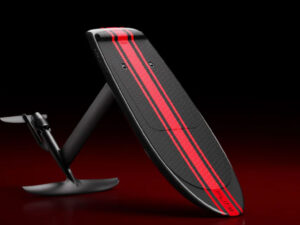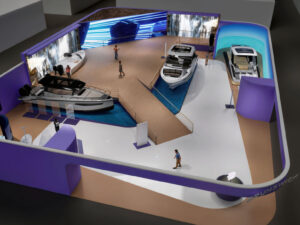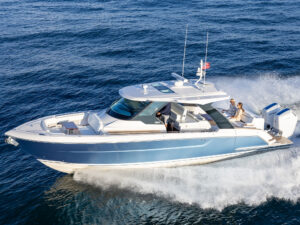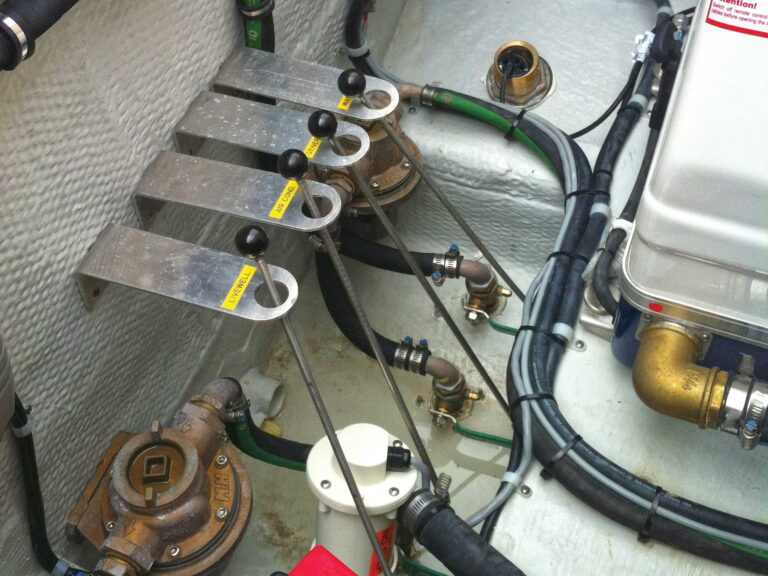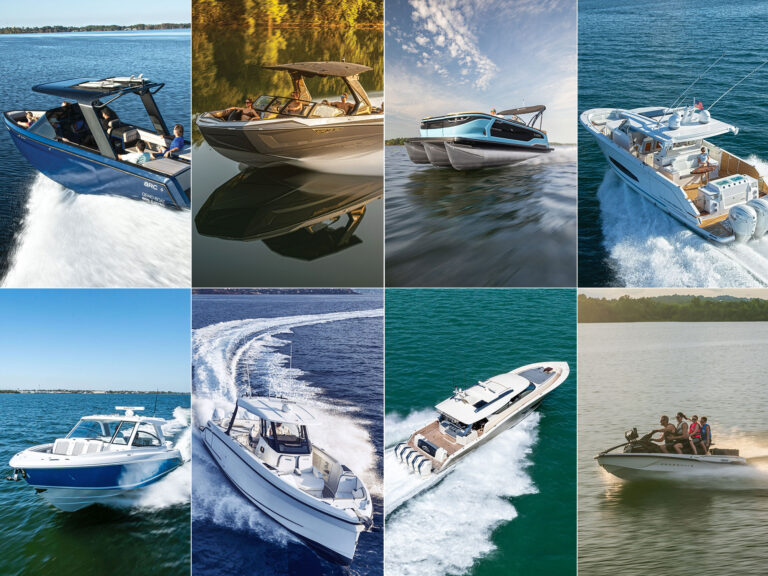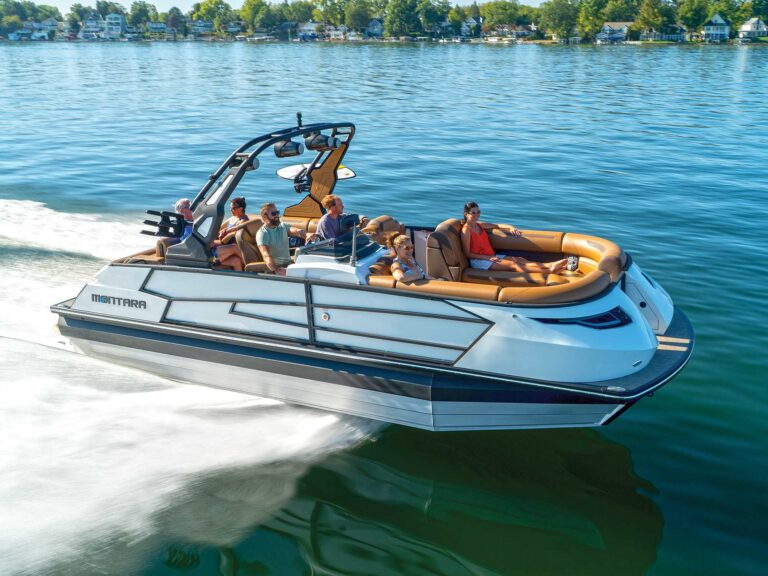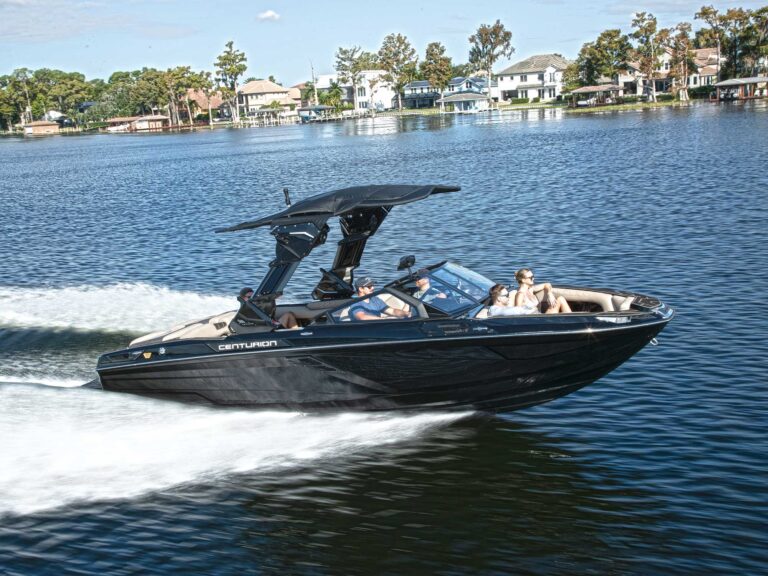
Capt. Jon Cooper has fished the patch reefs on the Atlantic side of Florida’s upper Keys for years, using his chart plotter to zero in on small, rocky outcroppings to drop a line for tasty hogfish or dive for succulent lobsters.
This day was different. We weren’t on Cooper’s well-equipped boat; rather, we were testing one so new, it had no display. No chart plotter. No GPS. No nuthin’.
So he went to Plan B. From his pocket, Cooper pulled out his iPhone loaded with the Navionics Boating app and entered the latitude and longitude for one of his favorite spots.
Almost instantly, he was navigating with the same detail and features you might find on a conventional chart plotter. The iPhone showed his boat’s position and track as we approached the spot and set the anchor. Within minutes, we were catching fish.
Might Cooper’s Plan B become Plan A in the future?
One thing’s for sure: Mobile devices are taking over more and more functions that were once the exclusive domain of pricey multifunction displays.
In the ever-advancing world of marine electronics, tablets and smartphones today already serve as adjuncts to conventional displays for monitoring and controlling onboard functions. And we’re talking about more than just Bluetooth connectivity with an onboard stereo.
Touchscreen mobile devices with special apps and wireless capabilities allow you to view and control complex systems such as chart plotters, fish finders, radar, autopilots, thermal imaging and even marine motors.
New examples of this emerge continually from marine electronics brands such as Garmin, Furuno, Raymarine and Simrad, as well as engine companies such as Mercury Marine.
Let’s look at where this trend is heading and some examples of what’s available today, as well as some hurdles that mobile devices must overcome before they can truly become a boater’s best friend.
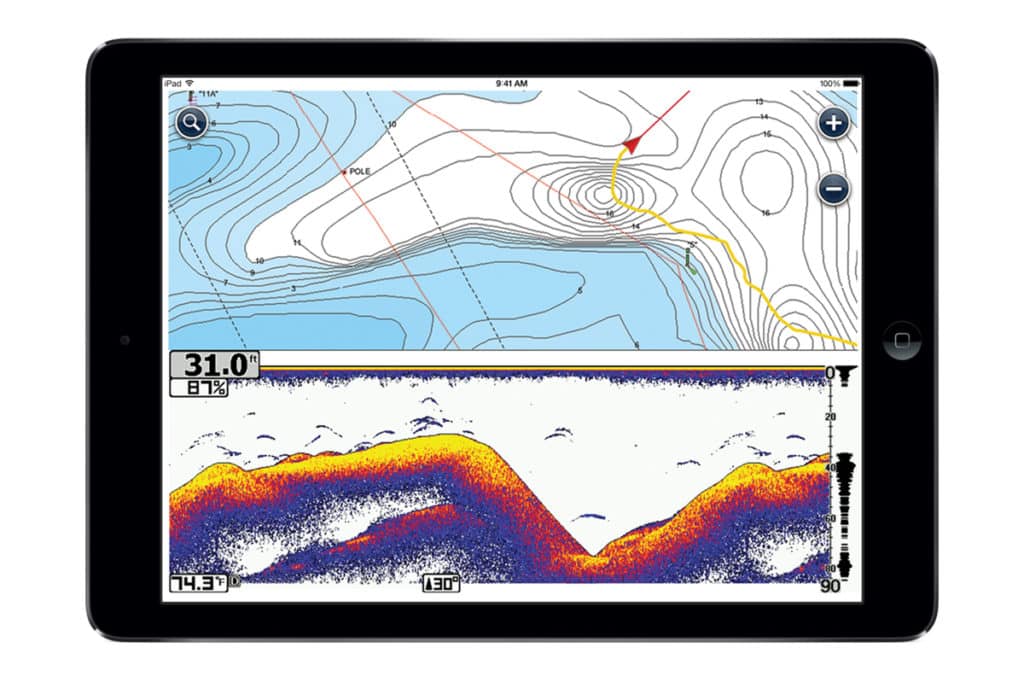
Wireless Wonders
A key element to a mobile device’s usefulness is wireless delivery of information to and from onboard systems. This allows you, for instance, to turn your smartphone into a fish-finder display.
To pull off this feat of mobile-device magic, you need a Vexilar SonarPhone system ($149.95, sonarphone.mobi), which includes a transom-mount transducer and a 12-volt-powered T-Box that serves as a Wi-Fi hotspot. Download the free SonarPhone app and connect with the T-Box, and your smartphone or tablet becomes a fish finder.
As if that weren’t enough, you can create a split-screen view of the fish finder and chart plotter together on a smartphone or tablet, just as you might on an MFD, with the Navionics Boating app ($99.99 per year, navionics.com).
The app allows you to connect wirelessly with a Wi-Fi-enabled sonar source such as a Raymarine Wi-Fish, Lowrance HDS Gen3 display or SonarPhone.
Not only does this show you a fish finder and chart plotter on one screen, but it also instantly enhances the chart’s detail by using a feature called SonarChart Live. By automatically cross-referencing the fish-finder data with coordinates on the chart, it records the details of wrecks, reefs, channels and ledges in real time, creating personal charts you can use immediately and in the future.

Radar Love
While chart-plotter and fish-finder apps illuminate what’s below the boat, other mobile technologies let you see around the boat.
Furuno’s DRS4W 1st Watch Wireless radar system ($1,229, thegpsstore.com), for example, relies entirely on a smartphone or tablet to serve as the display. The 12-volt-powered radome contains a Wi-Fi transmitter that connects with an iPhone or iPad via a free app to display radar returns on up to two devices at once.
With an iPhone, you can adjust the 4 kW radar range from 0.125 to 24 nautical miles. An iPad offers the same ability, but you can also determine bearing and distance of targets. It is the most overt example yet of mobile devices taking over the functionality of conventional displays.

Yet the most remarkable and innovative examples of wireless control of an onboard system with a mobile device might be the RayControl app (for tablets) and RayRemote app (for smartphones).
With these free apps, you can manipulate the FLIR T300, T400 and MD series thermal-imaging cameras (via a Raymarine display). Wherever you swing your smartphone or tablet — up, down or sideways — the FLIR camera follows.
This eliminates the need to toggle the camera in the direction you want to look — just point your mobile device. The thermal image is displayed on your phone or tablet, as well as the onboard display.

Pilot Programs
Autopilot remotes have been around for years, but mobile devices are making functionality inroads here as well. With a Raymarine Evolution R4 autopilot and compatible display, for instance, you can control the autopilot wirelessly on a tablet via the RayControl app.
Technology — or perhaps liability concern — has not reached the point at which you can control a main propulsion system via a mobile device. Yet there are ways to keep tabs on your marine engine with a smartphone or tablet.
One of the most notable examples is Mercury Marine’s VesselView app. It provides wireless access to engine instrumentation and other data on both iOS and Android mobile devices. The app is free, but you need the VesselView Mobile wireless module ($275 at Mercury dealers) to connect. The app also includes maintenance reminders, performance summaries and more.
In one of the most comprehensive mobile apps in boating, Boston Whaler’s 420 Outrage — Boating’s 2015 Boat of the Year — comes with Whaler Watch, an iPad app that lets you wirelessly monitor and control parameters related to security, marine electronics and digital switching.
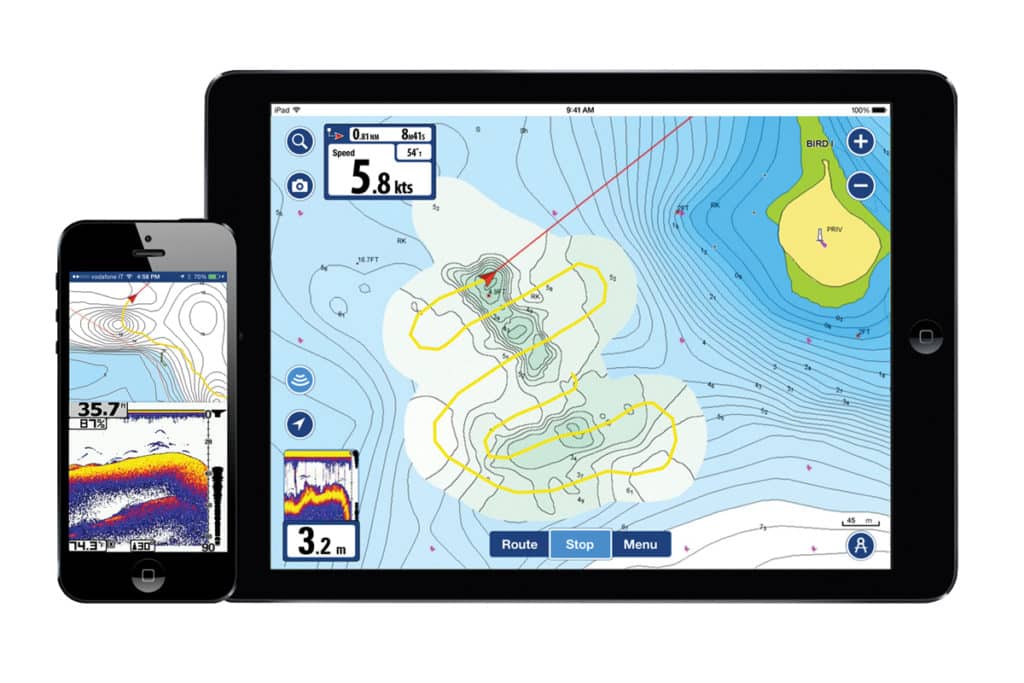
Mobile Movement
In many cases, the companies that offer today’s conventional marine displays are the same entities driving the trend toward developing apps for mobile devices. Simrad’s GoFree app is a prime example, allowing you to replicate screens and controls for sonar, chart plotters and more.
With this mind, it’s easy to envision a day in the not-too-distant future when a big-screen tablet (now available with HD displays in excess of 18 inches) or so-called “phablet” (a large phone with a screen up to 6 inches) takes the place of a multifunction display.
You carry the device aboard, secure it in a mount, and connect wirelessly with all systems. When you’re done for the day, you take it back home to review data or plan the next trip.
This scenario somewhat parallels the decline of GPS displays in the automobile market where mobile devices with navigation apps now dominate.
“This appears to be the way that marine electronics are moving,” says David Dunn, senior manager of marine sales and marketing for Garmin. While companies such as Garmin, Furuno, Simrad and Raymarine are looking ahead, they also recognize the current deficiencies of tablets and smartphones in a marine environment.

Visible Flaw
One of the biggest downsides of mobile devices is daylight viewing. If you have ever tried to read the screen on your smartphone or tablet in direct sunlight, you realize the problem — one that could threaten the safety of you and your crew if you misread information while navigating with a difficult-to-read mobile device.
“A marine multifunction display is daylight-viewable, but a tablet can be tough to read in bright sun,” says Jim McGowan, marketing manager for Raymarine.
Marine displays have nit ratings (a measure of visible light intensity) as high as 1,500, while most tablets are around 300 nit. As display technology advances, daylight viewing of mobile devices might improve as well, though the more light you pump in, the greater the demand on a device’s battery.
Moisture poses another concern with mobile devices. Few are waterproof. Most marine displays, on the other hand, meet IPX7 standards for waterproofing. While there are some waterproof mobile devices, such as the Bak USA Seal 8 marine tablet ($575, bak-usa.myshopify.com), Kyocera Hydro Wave ($69.88, walmart.com) and Samsung S7 ($99.99, bestbuy.com), waterproof cases are needed for others.
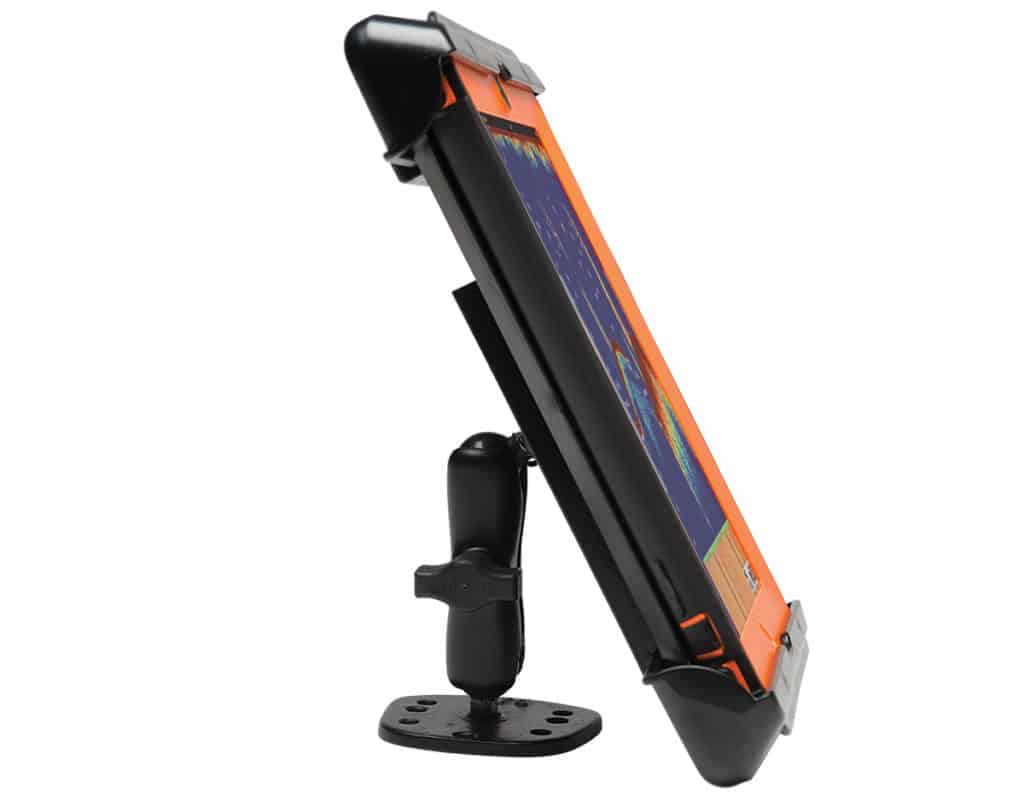
Make It Secure
The very mobility of a tablet or smartphone also poses problems aboard a boat. It’s difficult to hold, view and tap a mobile device while manning the helm. An unsecured tablet or phone will slide around, fall on the deck or go overboard.
A solution comes in the form of mounting systems from companies such as RAM Mounts, which offers surface- and rail-mount, adjustable ball-and-socket mechanisms with special frames for securing tablets and mobile devices. Quick-release systems let you easily mount or dismount the mobile device. When mounting a mobile device, be sure there’s a charging source nearby.
Some boaters have expressed concerns about the processing speed in a mobile device. Yet, as Furuno has demonstrated with its 1st Watch wireless marine radar and Vexilar has shown with its SonarPhone, most of the digital processing can take place elsewhere, with the mobile device serving as the means of displaying information.
That doesn’t mean that mobile devices are short on processing power and speed. The Samsung Galaxy View — the largest tablet, with an 18.4-inch screen — runs at 1.6 GHz; the iPhone 6 Plus runs at 1.4 GHz.
While marine electronics companies are reluctant to reveal processing specs, some reveal that those speeds are actually on par with, if not somewhat faster than, a number of high-end multifunction displays.
We now rely on smartphones and tablets for virtually everything we do. Though some boaters seek to put them aside while afloat, it appears that these miraculous devices will someday become integral in the use of our boats, moving from our pockets and backpacks to the helms of the future.
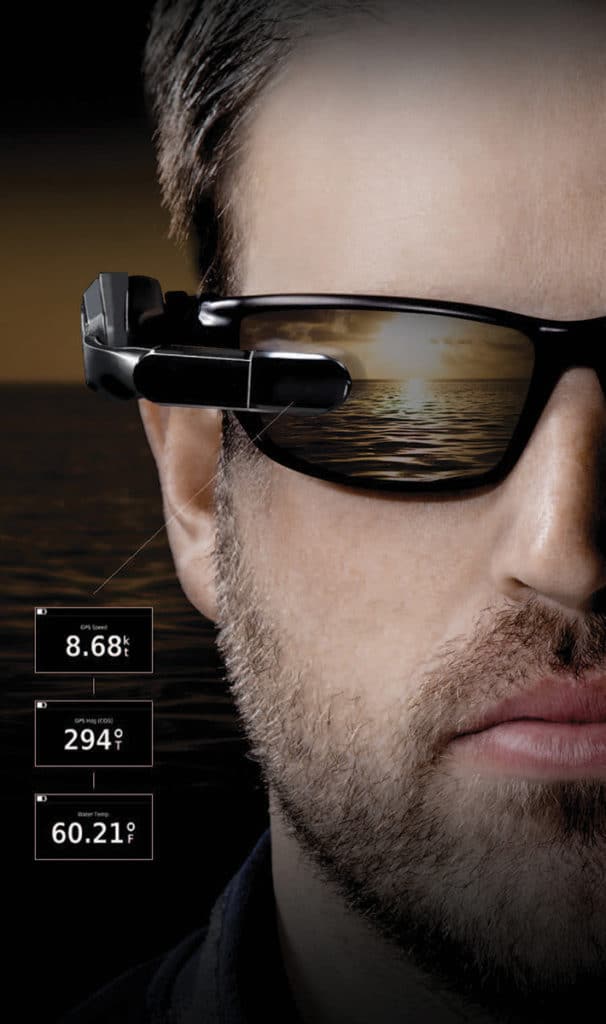
Garmin’s senior manager of marketing and sales, David Dunn, asked me to remove my sunglasses and hand them over as we idled along the Intracoastal Waterway off Miami, Florida. Dunn attached a small device to the right temple of the sunglasses and gave them back. In the corner of the right lens, key navigation data appeared, delivered wirelessly via the compatible onboard Garmin marine electronics network. Garmin’s hands-free Nautix represents a new breed of Wi-Fi-enabled mobile devices that show information traditionally provided by marine displays and gauges. The heads-up display helps to keep your eyes ahead, a critical safety feature when running at speed. The Nautix features eight hours of always-on battery life and a wet-weather-friendly touch panel for rotating between displays. It weighs 1 ounce and can be mounted on the left or right temple. Compatible Garmin displays include the GPSMap 7400/7900 and 8400/8600. $399.99; garmin.com Garmin


